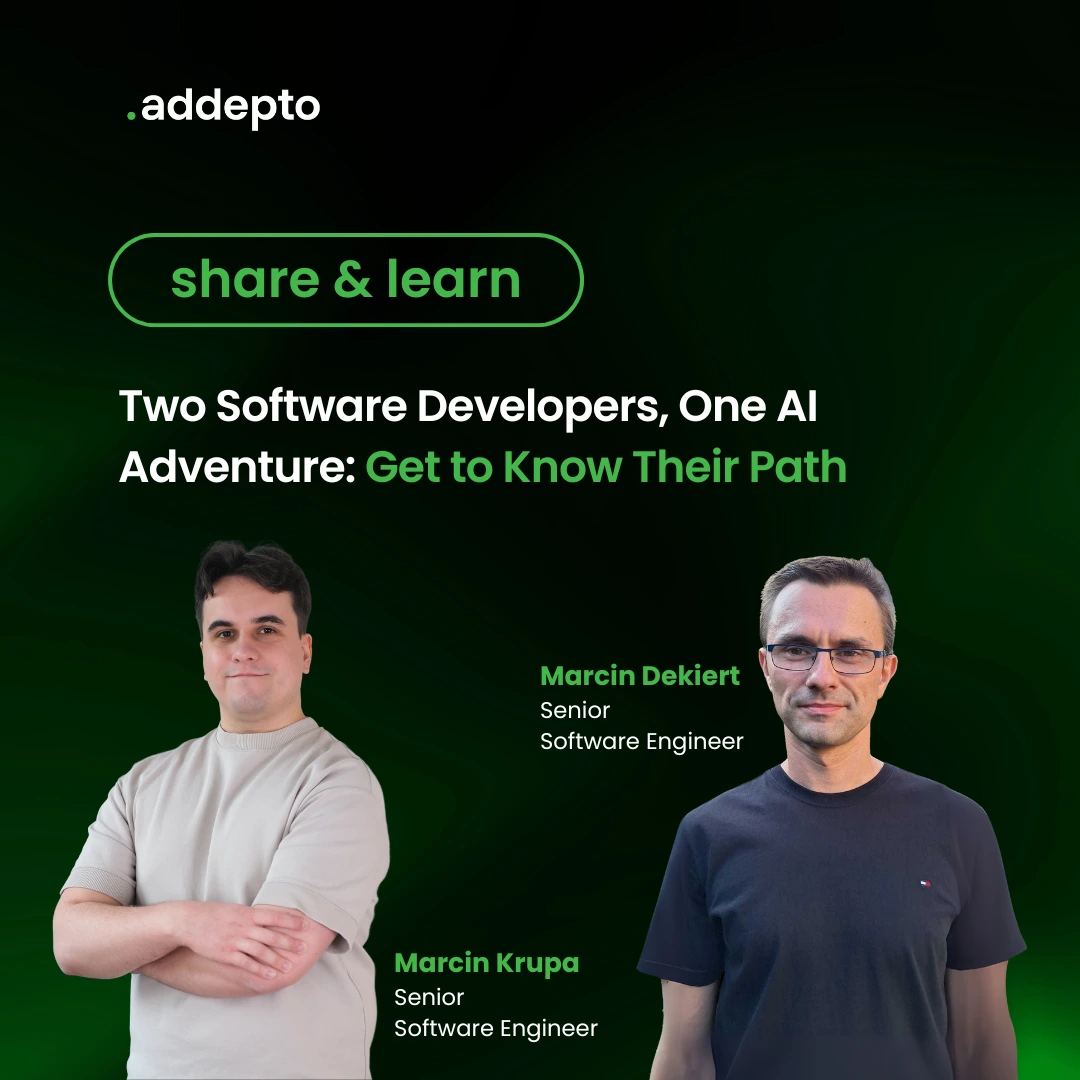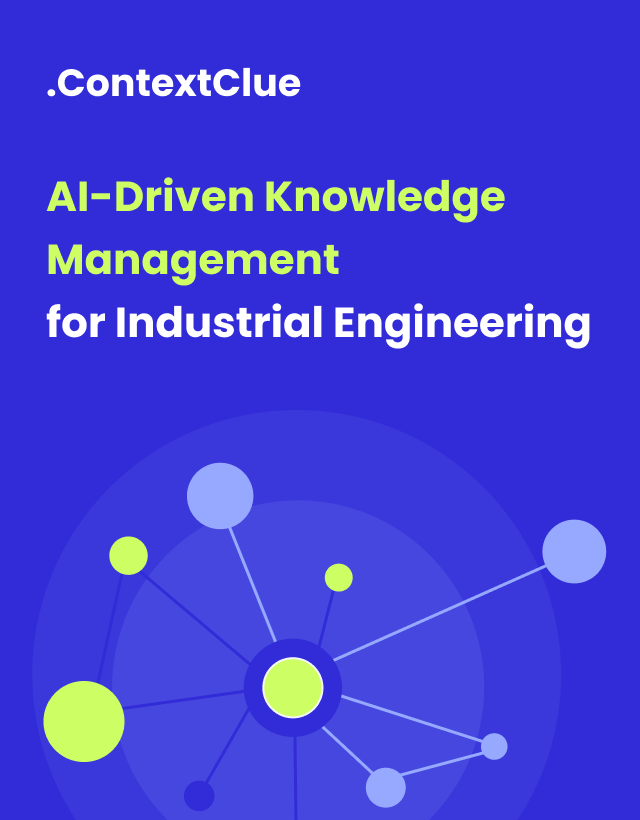
September 23, 2025
Two Software Developers, one AI adventure: Get to know their path
Author:

Talent Acquisition Partner
Reading time:
9 minutes
As AI continues to transform the software development landscape, many developers are wondering how to gradually expand their skills to include machine learning, AI tools, and related technologies. To shed some light on this, our Talent Acquisition Partner Ania talked with two of our developers, Marcin Dekiert and Marcin Krupa, who shared their personal journeys into AI, the challenges they faced, and the lessons they’ve learned along the way.

Ania: Let’s start from the beginning: how did you end up working on AI-related projects as software developers?
Marcin D: At some point, I felt I wanted to try something new. After so many years of building similar kinds of solutions – with different requirements and assumptions, but still based on the same experiences – I felt the need for change.
When my previous project ended, I started looking for a place where I could learn something related to AI. Of course, I could have done it on my own, but I decided it would be easier to step inside existing projects and see how it really works “from the kitchen.” That’s how I ended up at Addepto, where there happened to be a spot for a .NET developer… though honestly, the specific technology wasn’t the most important thing for me at that time.
Marcin K: For me, it started differently. I began in a cybersecurity company, focusing on pure backend development and DevOps topics. At the very beginning of my career, I wasn’t particularly interested in AI, but as I gained more experience, I started looking in that direction. Back then, before the AI boom, everything there seemed very exotic – even trivial problems looked fascinating. So when the opportunity came to work in an AI-related company at Addepto, I decided to give it a try. I wasn’t sure if I would enjoy it, but I did – and now I don’t think I’ll ever go back.
Ania: Did you feel you had to learn anything new to be effective in AI environments – or did your existing dev skills translate well?
Marcin K: Absolutely! I had to stretch myself quite a bit. While my background in backend development gave me a solid foundation, working in AI/ML meant learning a whole new set of tools and ways of thinking. I spent a lot of time getting up to speed on AI and ML concepts, experimenting with different Python libraries, and mastering cloud services I hadn’t used before. Beyond the technical side, it was fascinating figuring out how to apply my existing skills in a completely different context. That’s when it clicked for me.
Marcin D: Same here – there are definitely things you need to catch up on to navigate AI smoothly. It’s a bit like driving a car: you know there are pedals, a steering wheel, and switches, but you need to learn what’s what and in what order to use them. At the beginning, you get a big dose of theory that you need to digest to really understand what the team is discussing and where the problems come from. For me, the extra challenge was jumping quickly into Python, which I basically only knew existed before. The syntax itself wasn’t too hard, but the bigger challenge was shifting my way of thinking and understanding the coding style in that ecosystem. Luckily, my programming experience helped a lot, and the process went fairly smoothly – though I still need more practice to feel fully comfortable. Like with driving: passing the license test is just the beginning of real learning.
Ania: Can you walk us through a typical day in your role? What kind of problems are you solving with AI?
Marcin D: In my current project, we’re building a system that allows users to have a conversation with the client’s documentation. If I were to break it down, about 80% of the work is classic software development: planning the whole process, choosing solutions, processing and saving data, and making use of properly matched information. The remaining 20% is the AI part – figuring out how to best use available tools and implementing them. Of course, that “20%” can be more time-consuming than the rest, because it requires tests, experiments, fine-tuning, and adjustments. But in the end, what we get is a working system where our own algorithms are supported by the latest AI “boosters.”
Marcin K: And for me, a big part of the job is making sure those models don’t just work in theory but also in production. Deploying AI models isn’t simply pressing “run.” You need to treat them like any other software: with version control, monitoring, and clear update processes. But you also have to be ready to troubleshoot and refine, because models don’t always behave the way you expect outside the lab. I learned that the hard way. With AI, you also start thinking about data quality, performance over time, and how users interact with the system much earlier in the process. The key insight is: AI isn’t magic – it needs solid engineering practices to work effectively in real-world scenarios.
Ania: Do you think working on AI projects changed the way you approach software development?
Marcin K: Definitely. With models in the mix, you start considering many more aspects from the very beginning: not just features, but also reliability, trust, and how systems evolve over time. It’s not just about writing code anymore – it’s about ensuring AI is a trustworthy tool, not just a smart one.
Marcin D: I’d agree. For me, AI completely changed the way I look at software development. Until now, everything revolved around data and processes – how to optimize, automate, or speed things up. AI adds a new layer: suddenly, we can not only execute instructions but also interpret, understand context, and support user decisions. It makes projects more creative, and it expands the role of a developer beyond just coding.
Ania: Is understanding machine learning theory necessary for your job – or is it more about knowing how to work with APIs, pipelines, etc.?
Marcin D: In my role, I don’t need to be an expert in ML theory. It’s a huge and important field, of course, but in everyday projects, it’s more about being able to use existing tools, integrate APIs, build pipelines, and manage the system around them. It is important to understand the basic concepts and know what’s happening in the background, but I don’t need to build models from scratch myself. What matters most is making the product work and deliver value to the user.
Marcin K: I feel the same. Knowing ML/AI theory is helpful, but it’s not always required, especially if you have a strong team that can cover knowledge gaps. In my role, being comfortable with APIs, pipelines, and deployment is often more important. That said, even a basic understanding of theory makes it easier to collaborate and to understand why things work – or why they don’t.
Ania: What do you think the role of a software developer in AI will look like in 5 years?
Marcin K: Well, first of all, I hope there will still be a role for software developers! Looking ahead, I don’t think developers will spend much time building models from scratch anymore. Instead, I think we’ll focus on making sure AI is a trustworthy tool and not just “smart.”
Marcin D: Honestly, I can’t imagine exactly what it will look like. For me, the current state of AI is, first and foremost, a great tool that we need to use wisely. We should remember that business defines the needs, and technology should adapt to them – not the other way around. That’s why I don’t think developers will start looking only “through the AI lens” or rely solely on tools like ChatGPT. That would be a dangerous oversimplification. I believe the role of a developer will evolve into someone who not only writes code but can also critically assess when and how it makes sense to use AI, and when other solutions are better.
Ania: Do you think AI is becoming more accessible to developers – or is the barrier to entry still too high?
Marcin D: Today, the barriers are mostly the ones we create for ourselves. With internet access and a computer, you can explore practically any field – AI is no exception. The real challenge is time. But if you can spare even a little bit daily, you can dive in. Still, I’d say it’s important not to stop at “writing prompts for ready-made agents.” The true value comes when you start to understand how these tools work and how to use them creatively.
Marcin K: I agree. Cloud services, pre-trained models, and easy-to-use APIs have made it possible to experiment and build without a PhD in machine learning. Of course, if you want to run things well in production, there’s still a learning curve – but the entry barrier is definitely much lower than it used to be.
Ania: What tools or best practices would you recommend to a software developer who wants to start working with AI or machine learning?
Marcin K: If you’re just starting, I’d say: start small and experiment. Pick a project that genuinely interests you, use Python and some popular libraries like scikit-learn or PyTorch, and don’t hesitate to rely on pre-trained models. You’ll learn best by trying and solving challenges as they appear.
Marcin D: My main recommendation is: first get the basic concepts, and then build a small micro-project – your own “hello world.” For example, try embedding, using both local tools and available online services. That hands-on experience gives you a completely different understanding than just reading documentation. And most importantly: never close yourself off to new things. That mindset helps not only in AI but in all areas of software development.
Ania: Getting started with AI as a software developer is about more than learning new tools – it’s about adapting your mindset, experimenting, and continuously growing. Those who take this approach can unlock new opportunities and add real value to their projects. Thank you both for sharing your journeys and perspectives. It’s inspiring to see how different backgrounds can lead to AI, and how both of you highlight the importance of continuous learning, experimentation, and critical thinking.
Category:




